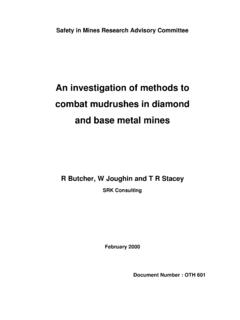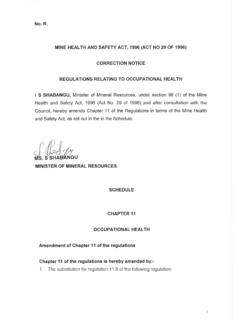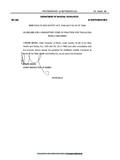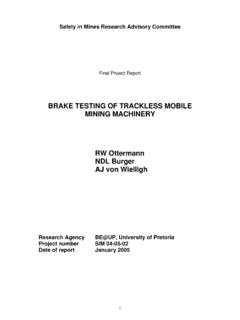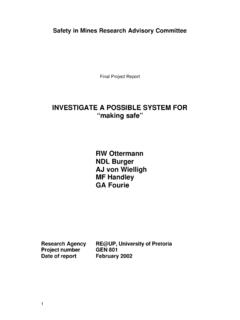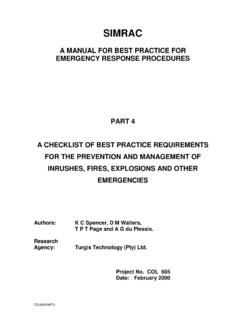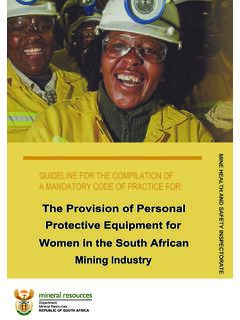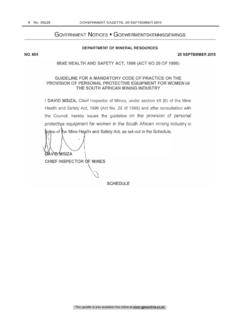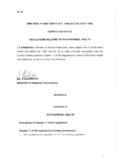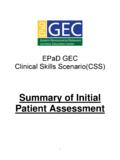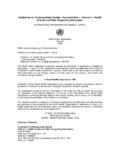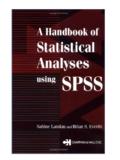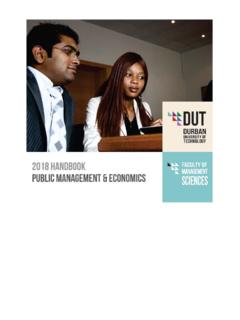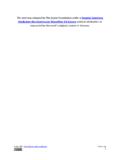Transcription of 1.0 INTRODUCTION 1.1 Prevalence of substance use
1 INTRODUCTION Alcohol misuse is one of the most significant public health concerns facing South Africa today. Globally, cannabis is the most widely used illicit drug, with an estimated 144 million people using it annually (1). It constitutes the main drug of abuse in Africa (2). substance abuse is associated with employee illness, occupational accidents, increased health services utilisation, and decreased productivity (3,4). However, despite the fact that South Africa is one of the major mining countries in the world, local research on alcohol and cannabis use among mineworkers is limited.
2 Prevalence of substance use It is estimated that 6% to 16% of the average workforce is likely to be alcohol dependent and that a further 20% is likely to experience drug related problems (5,6). In South Africa, the Prevalence of alcohol dependence among adults is estimated as 10%, while that of risky drinking among workforces such as the mining industry has been estimated at 25% or more (7). In a South African gold mine, the Prevalence of risky drinking among workers was found to be 32% and the majority of these employees were in unskilled or semiskilled occupations (8).
3 In another study carried out in South Africa, the highest rates of alcohol abuse as a household problem (32%) were reported among unskilled manual workers, while the lowest rates ( ) occurred among professionals (9). Among miners in Argentina, 34% were found to be weekly alcohol drinkers, while 65% chewed coca leaves daily (10). In 1984, the Addiction Research Foundation in Canada reported that 11% of adults in Ontario above 18 years old used cannabis (11).
4 Factors associated with substance use Historically, practices in the Mining and Agriculture industries such as the dop system, migrant labour system, availability of cheap or free alcohol, and availability of alcohol on credit, may have contributed towards increased alcohol use in the South African workforce. The dop system, officially prohibited in 1961, entails payment of workers with alcohol in lieu of wages (12,13). Factors, which may contribute to cannabis use, include the fact that it is inexpensive, easy to procure, prosecution is infrequently enforced, and is perceived by many not to be problematic (1).
5 Poverty, boredom, and inadequate health education, have also been associated with substance use (14). In a South African gold mine the lifestyle of miners such as living apart from families for prolonged periods was found to encourage unhealthy alcohol consumption (14). Higher rates of alcohol use have been found among miners who have only ever worked underground compared to those who work aboveground, and among miners with a heavy workload (10).
6 Daily use of coca was also found to be significantly higher among miners with a heavy workload (10). Stressful 2 working conditions as are found underground, and heavy workloads may encourage alcohol and drug use, which may serve as a coping mechanism (15,16). Stress, loneliness, and boredom have also been cited as reasons for alcohol use by South African mine workers (8). Effects of substance use Effects of alcohol use Absenteeism, sick leave, and accidents have been found to be higher among workers who use excessive alcohol (3,17).
7 In a South African pulp mill, blood alcohol was found to be positive in 18% of cases of injury, while in a copper mine in Zambia, blood alcohol was positive in 30% of accident cases (17,18). Excessive alcohol use is also associated with social problems like violence, and can predispose to illnesses such as hypertension, gastritis, liver cirrhosis, gout, tuberculosis, and physical dependence with withdrawal symptoms, and depression (19). Effects of cannabis use Regular cannabis use has been associated with impaired social and occupational functioning (20).
8 The primary psychoactive constituent is delta-9-tetrahydrocannabinoid (THC) (21). Cannabis use results in feelings of euphoria and relaxation, and acute effects include impairment of attention and short-term memory, and loss of coordination (22,23,24). Chronic effects include psychological dependence characterised by deterioration in psychosocial functioning; subtle cognitive deficits, particularly attention, learning, and executive functioning (organising and integrating of information); possible triggering of onset of schizophrenia; increased vulnerability to respiratory illnesses; impaired lung function; and precancerous changes in lung tissue (1,20).
9 Screening tools for substance use Screening tools for alcohol dependence The Diagnostic and Statistical Manual of the American Psychiatric Association, 4th edition (DSM-IV), defines alcohol abuse as a pattern of use which leads to clinically significant impairment or distress, as manifested by one (or more) of the following in a 12-month period (7): ? Recurrent alcohol use resulting in a failure to fulfil major role obligations at home, school, or work ? Use of alcohol in situations in which it is physically hazardous ( driving a car) ?
10 Recurrent alcohol use leading to legal problems ( drunken driving) ? Continued alcohol use despite persistent or recurrent social or interpersonal problems caused or exacerbated by alcohol. 3 Screening tools for alcohol misuse include the CAGE, the AUDIT (Alcohol Use Disorder Identification Test), and the brief MAST (Michigan Alcohol Screening Test) questionnaires (25,26,27). They are specific and reliable, and help to screen individuals who require further assessment for alcohol dependence.
